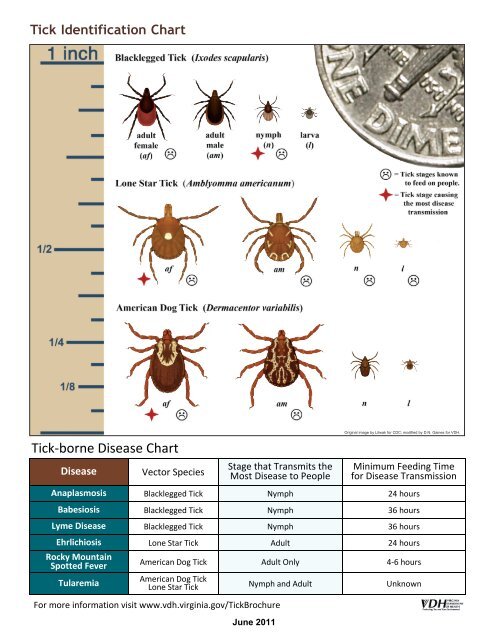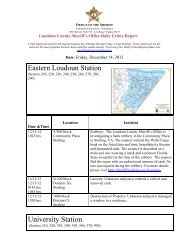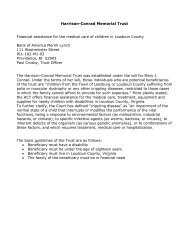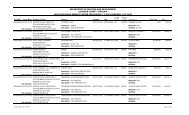Tick Identification Chart - Loudoun County
Tick Identification Chart - Loudoun County
Tick Identification Chart - Loudoun County
Create successful ePaper yourself
Turn your PDF publications into a flip-book with our unique Google optimized e-Paper software.
<strong>Tick</strong> <strong>Identification</strong> <strong>Chart</strong><br />
<strong>Tick</strong>-borne Disease <strong>Chart</strong><br />
Disease<br />
Vector Species<br />
Stage that Transmits the<br />
Most Disease to People<br />
Original image by Litwak for CDC; modified by D.N. Gaines for VDH.<br />
Minimum Feeding Time<br />
for Disease Transmission<br />
Anaplasmosis Blacklegged <strong>Tick</strong> Nymph 24 hours<br />
Babesiosis Blacklegged <strong>Tick</strong> Nymph 36 hours<br />
Lyme Disease Blacklegged <strong>Tick</strong> Nymph 36 hours<br />
Ehrlichiosis Lone Star <strong>Tick</strong> Adult 24 hours<br />
Rocky Mountain<br />
Spotted Fever<br />
Tularemia<br />
American Dog <strong>Tick</strong> Adult Only 4-6 hours<br />
American Dog <strong>Tick</strong><br />
Lone Star <strong>Tick</strong> Nymph and Adult Unknown<br />
For more information visit www.vdh.virginia.gov/<strong>Tick</strong>Brochure<br />
June 2011
About <strong>Tick</strong>-borne Diseases in Virginia<br />
Anaplasmosis and Ehrlichiosis: Symptoms of ehrlichiosis and anaplasmosis occur 7-14 days after tick bite<br />
including fever, headaches, muscle pain, vomiting and general discomfort. Severe or fatal illness can occur and<br />
treatment should not be delayed.<br />
Babesiosis: Symptoms of babesiosis may take 1-3 weeks to appear; they include fever, chills muscle pains,<br />
fatigue and jaundice. Most people show no symptoms. Asplenic and immunocompromised patients may suffer<br />
severe or fatal illness.<br />
Lyme Disease: The first sign of LD is a circular or oval rash at least 2 inches<br />
in diameter called an erythema migrans (EM). The EM rash occurs 3-30 days<br />
after a tick bite and is accompanied by headaches, joint or muscle aches, fever<br />
and tiredness. The rash does not itch or hurt and may go unnoticed. When left<br />
untreated, LD may progress to affect the joints, nervous system and heart, and<br />
may cause long lasting arthritis and nervous system damage in some people.<br />
EM rash associated with lyme Lyme disease<br />
Spotted rash caused by RMSF<br />
Rocky Mountain Spotted Fever: Rocky Mountain spotted fever<br />
(RMSF) is a serious illness characterized by a sudden onset of symptoms.<br />
Symptoms may begin 2-14 days after a tick bite, including fever, deep muscle<br />
pain, severe headache, chills and upset stomach or vomiting. A red, spotted<br />
rash may appear beginning on the wrists and ankles and spreading to the<br />
palms, soles of feet and to the rest of the body. Treatment should begin as<br />
soon as RMSF is suspected. Untreated cases may be severe or fatal.<br />
Tularemia: Symptoms of tularemia include the sudden onset of fever and chills. An ulcer may develop at the bite<br />
site and the lymph nodes may become enlarged. Untreated cases may be severe or fatal.<br />
Preventing <strong>Tick</strong> Bites<br />
Recognize when you are in potential tick habitats<br />
such as tall grass, forest underbrush or leaf litter.<br />
Walk in the center of mowed trails, keep grass<br />
cut and rake leaves/clear brush in wooded yards.<br />
Wear light-colored clothing so ticks are visible.<br />
Tuck pant legs into socks or boots, tuck shirts<br />
into pants and wear long sleeved shirts.<br />
Apply repellents to skin containing up to 50%<br />
DEET for adults or less than 30% DEET for<br />
children.<br />
Repellents containing other active ingredients<br />
such as bioUD, oil of lemon eucalyptus, IR3535,<br />
picaridin, or 2-undecanone are also effective.<br />
Apply repellent containing 0.5% permethrin to<br />
clothing. Follow directions carefully and do not<br />
apply this repellent to skin.<br />
Conduct thorough tick checks after you have<br />
been in tick habitat; remove ticks promptly.<br />
How To Remove a <strong>Tick</strong><br />
Using tweezers, grasp tick near mouth parts<br />
as close to the skin as possible.<br />
Be careful not to squeeze the tick’s swollen<br />
abdomen.<br />
Pull tick in a steady, upward motion until it<br />
releases from the skin<br />
Other methods of tick removal are unsafe<br />
Disinfect hand and bite site with soap and<br />
water and apply antiseptic to the site.<br />
You may want to identify the tick and save it<br />
in alcohol for several weeks. If you become<br />
ill, the tick might help your doctor diagnose<br />
the illness.<br />
If you become ill and have been exposed to ticks, tell your doctor about your<br />
tick exposure.












